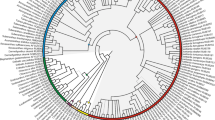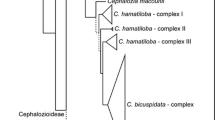Abstract
Tribe Spiraeeae has generally been defined to include Aruncus, Kelseya, Luetkea, Pentactina, Petrophyton, Sibiraea, and Spiraea. Recent phylogenetic analyses have supported inclusion of Holodiscus in this group. Spiraea, with 50-80 species distributed throughout the north temperate regions of the world, is by far the largest and most widespread genus in the tribe; the remaining genera have one to several species each. Phylogenetic analyses of nuclear ITS and chloroplast trnL-trnF nucleotide sequences for 33 species representing seven of the aforementioned genera plus Xerospiraea divided the tribe into two well supported clades, one including Aruncus, Luetkea, Holodiscus, and Xerospiraea, the second including the other genera. Within Spiraea, none of the three sections recognized by Rehder based on inflorescence morphology is supported as monophyletic. Our analyses suggest a western North American origin for the tribe, with several biogeographic events involving vicariance or dispersal between the Old and New Worlds having occurred within this group.
Similar content being viewed by others
References
Bharathan G., Goliber T. E., Moore C., Kessler S., Pham T. and Sinha N. R. (2002). Homologies in leaf form inferred from KNOXI gene expression during development. Science 296: 1858–1860
Bortiri E., Oh S., Jiang J., Baggett S., Granger A., Weeks C., Buckingham M., Potter D. and Parfitt D. (2001). Phylogeny and systematics of Prunus (Rosaceae) as determined by sequence analysis of ITS and the chloroplast trnL-trnF spacer DNA. Syst. Bot. 26: 797–807
de Candolle A. P. (1825) Prodromus systematis naturalis regni vegetabilis, sive, Enumeratio contracta ordinum generum specierumque plantarum huc usque cognitarium, juxta methodi naturalis, normas digesta. 2: 541. Treuttel et Würtz, Paris.
Doyle J. J. and Doyle J. L. (1987). A rapid DNA isolation procedure for small quantities of fresh leaf tissue. Phytochem. Bull. 19: 11–15
Evans R. C. and Dickinson T. A. (1999). Floral ontogeny and morphology in subfamily Spiraeoideae Endl. (Rosaceae). Int. J. Pl. Sci. 160: 981–1012
Henrickson J. (1985). Xerospiraea, a generic segregate of Spiraea (Rosaceae) from Mexico. Aliso 11: 199–211
Hooker W. J. (1834). Flora Boreali-Americana. I. H. G. Bohn, London
Huelsenbeck J. P. and Ronquist F. (2001). MRBAYES: Bayesian inference of phylogenetic trees. Bioinformatics 17: 754–755
Hutchinson J. (1964). The genera of flowering plants, vol. 1, Dicotyledons. Clarendon Press, Oxford
Kim M., Pham T., Hamidi A., McCormick S., Kuzoff R. K. and Sinha N. (2003). Reduced leaf complexity in tomato wiry mutants suggests a role for PHAN and KNOX genes in generating compound leaves. Development 130: 4405–4415
Kuntze O. (1891). Revisio Generum Plantarum 1: 1–375
Lingdi L. and Alexander C. (2003). Spiraea. In: Zhengyi, W., Raven, P. H. and Deyuan, H. (eds) Flora of China, vol. 9, pp 47–73. Missouri Botanical Garden Press, St. Louis
Linnaeus C. (1753) Species Plantarum I, 1st ed. Stockholm.
Maddison W. P. and Maddison D. R. (1999). MacClade, version 3.08. Analysis of phylogeny and character evolution. Sinauer Associates, Inc., Sunderland, Massachusetts
Masamune G. (1932). Genera plantarum formosamarum. Annual Rep. Taihoku Bot. Gard. 2: 123
Maximowicz C. J. (1879). Adnotationes de spiraeaces. Trudy Imp. S.-Peterburgsk. Bot. Sada 6: 105–261
Morgan D. R., Soltis D. E. and Robertson K. R. (1994). Systematic and evolutionary implications of rbcL sequence variation in Rosaceae. Amer. J. Bot. 81: 890–903
Nylander J. A. A. (2005) MrAIC, version 1.4., available at http://www.abc.se/~nylander/.
Potter D., Eriksson T., Evans R. C., Oh S., Smedmark J., Morgan D. R., Kerr M., Robertson K. R., Arsenault M. and Campbell C. S. (2007). Phylogeny and classification of Rosaceae. Pl. Syst. Evol. 266: 5–43
Potter D., Gao F., Bortiri P. E., Oh S. and Baggett S. (2002). Phylogenetic relationships in Rosaceae inferred from chloroplast matK and trnL-trnF nucleotide sequence data. Pl. Syst. Evol. 231: 77–89
Poyarkova A. I. (1939). Spiraeoideae. In: Borisova, A. G., Komarov, V. L., Krishtofovich, A. N., Lozina-Lozinskaya, A. S., Maleev, V. P., Palibin, I. V., Poyarkova, A. I., Tsinzerling, Yu. D. and Yuzepchuk, S. V. (eds) Flora of the U.S.S.R, pp 216–245. Izdatel-stvo Akademii Nauk SSSR, Moscow
Rehder A. (1940). Manual of cultivated trees and shrubs. Dioscorides Press, Portland
Rydberg P. A. (1900). Catalogue of the flora of Montana. Mem. New York Bot. Gard. 1: 1–492
Schulze-Menz G. K. (1964). Rosaceae. In: Melchior, H. (eds) Engler's Syllabus der Pflanzenfamilien II, pp 209–218. Gebrüder Borntraeger, Berlin
Swofford D. L. (2002). PAUP* Phylogenetic Analysis Using Parsimony (* and Other Methods) Version 4. Sinauer Associates, Sunderland, Massachusetts
Taberlet P., Gielly L., Pautou G. and Bouvet J. (1991). Universal primers for amplification of three non-coding regions of chloroplast DNA. Pl. Molec. Biol. 17(5): 1105–1109
Takhtajan A. (1997). Diversity and classification of flowering plants. Columbia University Press, New York
Thompson J. D., Gibson T. J., Plewniak F., Jeanmougin F. and Higgins D. G. (1997). The CLUSTALX windows interface: flexible strategies for multiple sequence alignment aided by quality analysis tools. Nucl. Acids Res. 25: 4876–4882
Watson S. (1890a). Contributions to American botany. IX. Proc. Am. Acad. Arts 25: 124–163
Watson S. (1890b). On the genus Eriogynia Bot. Gaz. 15: 241–242
White T. J., Bruns T., Lee S. and Taylor J. (1990). Amplification and direct sequencing of fungal ribosomal RNA genes for phylogenetics. In: Innis, M. A., Gelfand, D. H., Sninsky, J. J., and White, T. J. (eds) PCR protocols: a guide to methods and applications, pp 315–322. Academic Press, San Diego
Author information
Authors and Affiliations
Corresponding author
Rights and permissions
About this article
Cite this article
Potter, D., Still, S., Grebenc, T. et al. Phylogenetic relationships in tribe Spiraeeae (Rosaceae) inferred from nucleotide sequence data. Plant Syst. Evol. 266, 105–118 (2007). https://doi.org/10.1007/s00606-007-0544-z
Received:
Accepted:
Published:
Issue Date:
DOI: https://doi.org/10.1007/s00606-007-0544-z




